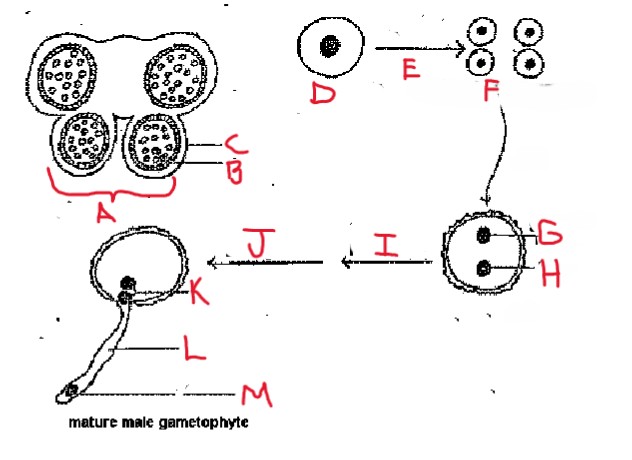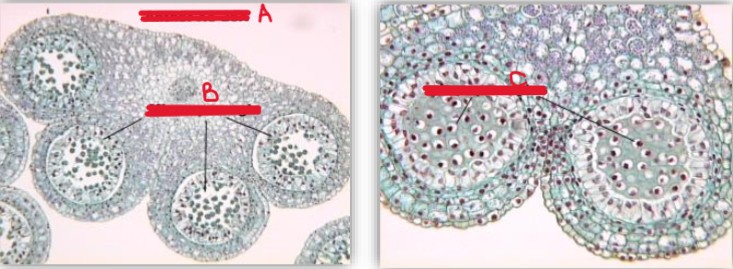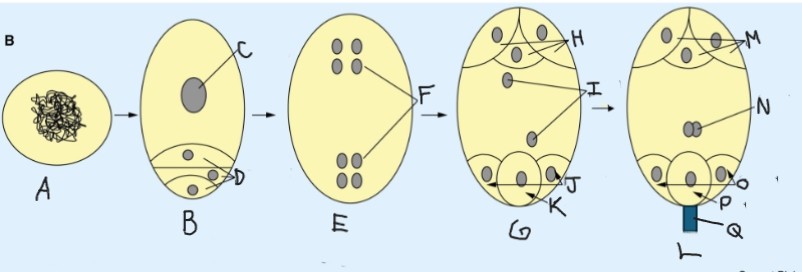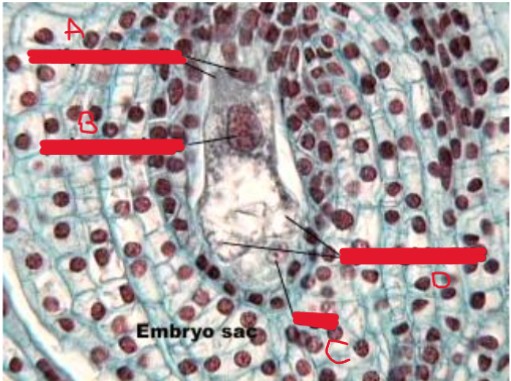Vascular plants lab - 8
1/56
There's no tags or description
Looks like no tags are added yet.
Name | Mastery | Learn | Test | Matching | Spaced |
|---|
No study sessions yet.
57 Terms
Gymnosperm life cycle - first spring (microsporangiate cones)
microsporocytes do meiosis in spring to produce microspores
Some mitosis occurs immediately to produce the mature microgametophyte with three cells (i.e. pollen grain).
Pollen is released and is transferred to the ovulate cones (usually a
different tree) by wind
Gymnosperm life cycle - first spring (megasporocyte cones)
pollen grains settle onto ovulate scales and adhere to 'pollination drops' that
exude from the micropyle canals at the open end of the ovulesThe drops contract and draw in the pollen grain into contact with the nucellus
The ovulate cone is now pollenated, and the scales grow together to protect the developing ovules
four megaspores are produced by each megasporocyte; only one eventually
develops into the megagametophyte while the other three degradepollen grains begin to germinate and slowly starts to form a pollen tube
gymnosperm life cycle - first fall
megagametophyte begins to develop by mitosis without cytokinesis and cell wall division and overwinters
Thus, the megagametophyte doesn’t even bother to start developing until
after pollination
gymnosperm life cycle - second spring
megagametophyte is now a blob of approx. 2000 free nuclei (free-nuclear stage)
Now it begins to make cell walls
the pollen tube is still growing into the developing megagametophyte, and
the generative cell divides to make a sterile cell and a spermatogenous cell,
the latter of which divides again to produce two sperm
gymnosperm life cycle - second summer
the megagametophyte has now produced archegona with egg cells
the pollen tube reaches the eggs and discharges the sperm
one sperm fertilizes the egg to produce a new 2n zygote and the other degenerates (pollination and fertilization occur 15ish months apart)
Zygote continues to do mitosis and form the 2n embryo
The integuments start developing into the seed coat
The remaining gametophyte is full of lipids, which are used to support the
growth of the new sporophyte when it sprouts
gymnosperm life cycle - second fall or third spring
The ovulate scales open and release the now fully-developed seed
how many cells in a mature microgametophyte (angiosperms)
2-3 nuclei
how many cells in a mature megagametophyte (angiosperms)
approximately 7 cells
do angiosperms have antheridia or archegonia
no
indirect pollination in angiosperms
the pollen grains are deposited on the stigma
after which the pollen tube conveys two non-motile sperm nuclei to the female gametophyte
what happens to the ovule and ovary after fertilization
the ovule, which is enclosed in the ovary, develops into a seed
the ovary develops into the fruit
microgametophyte (pollen) development
diploid microsporocyte divides by meiosis to produce 4 haploid microspores
each microspore divides by mitosis to produce a vegetative cell and a generative cell
a second division occurs in the generative cells to produce two sperm cells in the vegetative cell
megagametophyte development
megasporocyte (megaspore mother cell) undergoes meiosis to make 4 megaspores (three will degenerate)
The haploid functional megaspore does three rounds of mitosis without cytokinesis to produce eight haploid nuclei
The nuclei then migrate and produce different cell types: an egg cell, two synergid cells, three antipodal cells, and two central nuclei remain in the original mother cell cytoplasm (all together this structure is the embryo sack)
list the different cell types in the embryo sac
egg cell
2 synergid cells
three antipodal cells
two polar nuclei (one cell)
what cells in the embryo sac are closest to the micropyle
the egg cell and 2 synergid cells
fertilization in angiosperms
The pollen grain lands on the stigma and the pollen tube from the tube cell (vegetative cell) grows through the style, following ‘transmission tracts’
Once it gets to the ovary, the pollen tube finds the micropile by following chemical cues put out by the antipodal cells in the embryo sac
grows through micropile
the generative cell divides to produce two sperm, one of the sperm fertilizes the egg to form a zygote
double fertilization
The other sperm fertilizes the central cell with the polar nuclei to form a triploid (3n) endosperm tissue
This tissue fills up with nutrients as the seed develops, which is eventually used to feed the growing seedling once it germinates
only in angiosperms
the zygote develops into…
the embryo
integuments
outer coverings of the ovule that develop into the seed coat
the ovary wall forms…
the fruit
the ovule becomes…
the seed
what type of division occurs after fertilization
the diploid zygote divides through mitosis
what is produced from the first divisions of the zygote
basal cell
terminal cell
basal cell
divides transversely
terminal cell
divides longitudinally
what results from the division of the basal and terminal cells
a four celled proembryo
how does the suspensor develop
The suspensor develops from the lower cells in the pro-embryo via a series of transverse cell division
dermatogen cells and inner cells
the young embryo consists of external dermatogen cells and eight
internal cells from which the ground meristem and procambial cells will
originate
hypophysis
The suspensor cell on which the embryo rests
Through a series of cell divisions, the hypophysis will form eight cells (two tiers of four cells)
The tier closest to the suspensor will form the root cap while the tier closest to the embryo will differentiate into the radicle
3 layers of the ovary wall (fruit)
exocarp: outer layer, often called the skin
mesocarp: middle layer, often is fleshy
endocarp: inner layer, modified in many ways
simple fruits
one flower and one ovary
aggregate
single flower with many ovaries (multiple separate pistils)
ex: strawberries, magnolia, raspberries, blackberries
multiple fruits
fused ovaries of several fruits
a bunch of separate flowers on an inflorescence get fertilized and all their fruits grow together into one mass
ex: pineapples and figs
accessory fruits
ovary plus other floral tissues
examples of dry fruits
maple tree seeds
dandelions
acorns
nuts
examples of fleshy fruits
peach
cherry
cucumber
apple
dry fruit types
achene
samara
nuts
capsule
legume
follicle
silique
caryopsis
achene fruits
dry and one seeded fruit
lacks special seams that split to release the seed = indehiscent
pericarp is dry and close to seed coat but not completely attached
ex: sunflower seed and dandelions
samara fruits
dry fruit
the entire pericarp is thin and papery and surrounds the seed (helps with wind dispersal)
technically just an achene with a papery pericarp
ex: maple seeds
nuts
dry fruit
indehiscent (doesn’t have seams that split open)
hard dry pericarp not attached to the seed coat
essentially a big achene with a much thicker pericarp
ex: acorns
capsule fruits
dry fruits
pericarp is dry and tough
splits open along seams to release seeds (dehisces)
Usually the ovary that made a capsule is compound with multiple carpels and
multiple ovules in each carpel (lots of seeds)ex: poppies
legume fruit
dry fruit
unilocular with multiple seeds
pericarp splits along two seams
ex: beans and peanut
follicle fruit
dry fruit
unilocular with multiple seeds
splits along one seam only
ex: milkweed and magnolias
silique fruits
dry fruit
two fused carpels with length longer than width
seeds attached to a thin septum in the middle
splits along two seams
ex: canola
caryopsis fruit
dry fruits
pericarp is directly fused with the seed coat
large starchy endosperm
ex: grains
fleshy fruit types
pome
drupe
berry
pepo
hesperidium
pome fruits
fleshy fruit
hypanthium/floral tube becomes the fleshy part
true fruit is tougher and in the middle
accessory fruit
ex: apples and pears
drupe fruit
fleshy fruit
stone fruits
exocarp is skin like
mesocarp is fleshy
endocarp is the stone
ex: peaches, coconut
berry fruits
fleshy fruit
simple - single flower and single ovary
exocarp skin-like
mesocarp and endocarp are fleshy or pulpy
ex: tomato, banana
pepo fruits
fleshy fruits
berry with a thick inseparable exocarp
fleshy mesocarp and endocarp
ex: melon and cucumber
hesperidium fruit
fleshy fruits
berry with a thick and leathery pericarp
with juicy locules and seeds on the inside
ex: lemons and oranges

identify a-m
a. anther
b. microsporocytes
c. microsporangium
d. microsporocyte (diploid)
e. meiosis
f. 4 haploid microspores
*for got to label next arrow as mitosis
g. generative nucleus
h. tube nucleus
g and h together = pollen grain
i. pollenation
j. germination on stigma
k. sperm nuclei
l. pollen tube
m. tube nucleus

identify the whole structure (A)
identify b and c
anther
b- microsporangia c- microsporocytes

identify the structures in the image
pollen grains (male gametophytes)

identify a-q
a. megaspore mother cell
b. female meiosis
c. functional megaspore
d. degenerated megaspores
e. eight-nucleate stage cell
f. nuclei
g. cellularization
h. anitpodal cells
i. central nuclei
j. synergid cells
k. egg cell
l. nuclei migration
m. antipodal cells
n. central nuclei
o. synergid cells
p. egg cell
q. micropile

identify a-g on the female sporangium
a. ovule
b. integuments
c. megasporocyte
d. ovule
e. megasporocyte
f. carpel
g. ovules

identify a-d on the embryo sac
a. antipodal cells
b. polar nucleus
c. egg
d. synergid cells